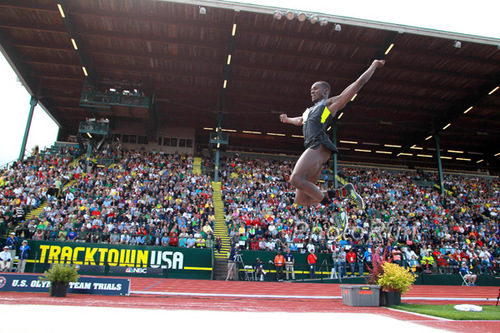Dave Hunter called me just before the holiday was over. Dave and I catch up about once a month and mostly talk track. My philosophy on my columnists is this: they know their subjects, we discus topics in broad sweeps, but, it is their thoughts and words that you, our readers, want to read.

New Year’s Wishes For U.S. Track & Field
The dawning of a new year is a hopeful time. The old year has passed and a clean slate is before us. As we take a step back and look ahead to 2014, here are a few wishes – in ascending order of importance – for U.S. Track & field in the coming year.
5. Greater US Influence In The Sport’s Global Governance. It is healthy for track & field when there is sport leadership provided by various countries – large and small and from various sectors of the world. But the United States – with the proven ability to consistently turn out the most talented, accomplished championship teams and with solid national leadership – has  earned the right to a more influential seat at the table of world governance. It would create the opportunity for the United States to speak out more effectively on issues which are plaguing the sport – like the wrong-headed A and B standards which needlessly complicate the sport and rob track & field of its fundamental purity: that simple justice which provides that those who run the fastest, throw the farthest, and jump the highest when it counts the most are accorded their due reward – period.
earned the right to a more influential seat at the table of world governance. It would create the opportunity for the United States to speak out more effectively on issues which are plaguing the sport – like the wrong-headed A and B standards which needlessly complicate the sport and rob track & field of its fundamental purity: that simple justice which provides that those who run the fastest, throw the farthest, and jump the highest when it counts the most are accorded their due reward – period.
4. More Marquee Performers With Exuberant Personalities. Usain Bolt is of course revered for his matchless performances on the track. But he also brings to the sport a certain entertainment value – an Ali-like swagger and a confidence bordering on braggadocio that evokes fan emotion and draws broad-based attention to the sport. Old-school purists may scoff at Bolt’s showmanship. But his Barnum-like, fun-loving approach to the serious business of world-class sprinting is providing a breath of fresh air to a sport that needs just that. Look around. We have others in the sport who bring their own special personalities to track & field: the unbridled joy of Mary Cain; the issue-oriented outspokenness of Nick Symmonds; the fun-loving candidness of Brigetta Barrett. The emergence of these genuine personalities should be encouraged, not thwarted.
3. A Workable Support System For Post-Collegiate Athletes. The United States has a functional system to cultivate young athletes in track & field. Though far from perfect, the U.S. framework generally provides high school and college support for those inclined to explore their potential in the sport. But after a track & field athlete graduates from college – at approximately age 22 – the support system vanishes for all but those very few who have performed at the highest level. This is problematic in a sport where – in more than a few events – athletes do not reach their full potential until their late 20’s or early 30’s. Corporate supporters and track & field leadership should consider creating a workable post-collegiate support system and installing a realistic method of funding it to be a wise investment to ensure the future of the sport we love. U.S. track & field needs the vision and the courage to do just that in order to support to those athletes who have the fire and the demonstrated potential to become world class athletes.
2. The Creation Of An Indoor Circuit. The older geezers in the sport remember when track & field had a robust indoor season – when athletes such as Jim Beatty and Bob Seagren set world bests in revered old indoor facilities in front of spectators – bunched closely in elevated seating – who were right on top of the action. The arrival of grand new indoor facilities – such as Spire Institute in Geneva, Ohio; the Randall Tyson Track Center in Fayetteville, Arkansas; and the Dempsey Indoor Facility in Seattle, Washington – combined with the loving restoration of the Washington Heights Armory clearly signal that the time is right for a rebirth of indoor track & field in America. “What we’re trying to do here is to build an indoor season,” offers Norb Sander, the visionary force behind the phoenix-like return of the Armory. “We want to start with the New Balance Games on the last weekend in January, then the Army Collegiate on the first week in February; then the Boston Indoor Grand Prix meet; then the Millrose Games; and then the national championship. But, of course, everybody has got to cooperate.” With the Armory’s transformation firmly establishing Sander’s street cred as a can-do force in the sport, there is more than sufficient reason to inspire others to cooperate.
1. Expanded Television Coverage – Domestic And Foreign. The single-most important 2014 wish for track & field would be expanded television coverage. Without doubt, the sport is doing a solid job in utilizing social media. But let’s face it: TV is still the most penetrating, broad-based medium – and will be for quite some time. The key for expanded TV coverage has to be a network, a cable venue, or simply even a visionary television executive who can appreciate that presenting a crisply-assembled broadcast of a sport which is the largest participatory high school sport in the country is not an unreasonable business risk. Television broadcasts of spirited European competition – pre-packaged and ready to go – already exist. They merely have to be made more readily available via a more widely-accessible television outlet. TV broadcasts popular sports, to be sure. But it must be recognized that television – a tremendously powerful medium – has the king-making capability to make sports popular. Plaintiff’s Exhibit A: NASCAR. Can there be any doubt that track & field would perform well on television if the TV “powers that be” decided to put their muscle behind the sport and make it so? There’s a reason why the wish for expanded television coverage should be ranked #1: If this wish could come true, the four other wishes – and many more – would fall right in line.
~Dave Hunter



















